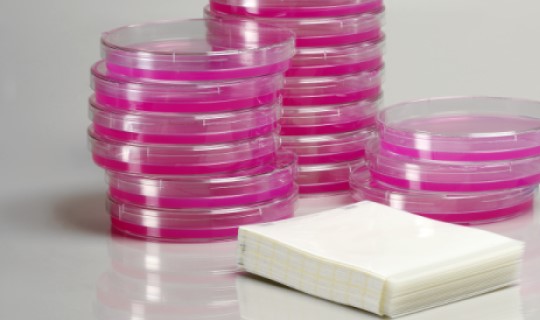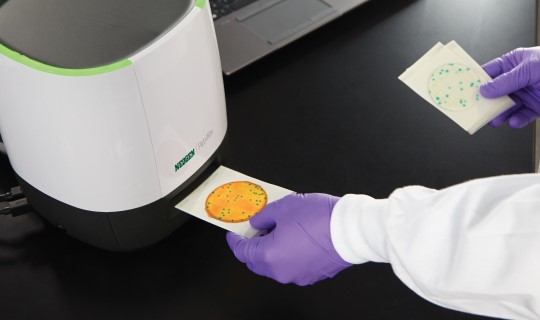Neogen® Petrifilm® Plates: A 40-year Legacy of Industry-leading Innovation in Food Safety Testing
May 01, 2024

The year was 1984. Apple had just introduced their new Macintosh computer to consumers. Richard Branson’s airline company, Virgin Atlantic Airways, made its inaugural flight from London to Newark. Mary Lou Retton scored a perfect 10 on her final vault — making her the first American woman to win an Olympic gymnastics gold medal.
Another monumental milestone that year? The world of microbiology was introduced to a new, more efficient, and accurate way to detect bacteria in foods, fundamentally changing the way microbiologists all over the world perform indicator testing.
In the 40 years since, Petrifilm Plates have become an industry standard — providing a simple, reliable, and consistent method for microbial testing in the food industry. However, like other historical disruptive innovations, the shift didn’t exactly happen overnight.
A game-changing idea
For nearly 100 years leading up to 1984, the primary way for microbiologists to accurately grow cell cultures in the lab was with the use of Petri dishes — shallow cylindrical glass-lidded dishes that contain agar — a thin layer of nutrient gel upon which bacteria can be cultured.
To use Petri dishes, lab technicians would spend hours preparing the agar and dishes, mixing media and agar, adding water, and adjusting the pH of the medium. Then, they would have to carefully autoclave (heat) and temper (cool) the solution to get it right for a diluted food sample in the Petri dish.
It's a cumbersome and tedious process. Which is exactly what sparked an idea for Bob Nelson, the senior scientist who is credited with the invention of Petrifilm Plates.
For his microbiology experiments, Bob had to prepare many Petri dishes of agar media. He didn’t enjoy the process — it was time-consuming and took away from the other, more important, tasks he wanted to be doing in the lab. He knew he couldn’t be the only scientist who felt this way — there had to be a better, more innovative way to do microbiology testing.
So, Bob visited microbiology labs to better understand their pain points and received similar feedback. He also noticed how much space was being taken up by prepared agar dishes in the labs. Lab staff complained to him that the agar dishes had a short shelf life, and they often expired, unused.

He had an idea: to create a ready-to-use, film-based agar test with a longer shelf life to eliminate the time-consuming and tedious task of pouring plates.
“The standout feature of the product, and probably the primary reason for its longevity, is its simplicity — there’s no need for customers to expend labor on preparing, plating, or reading agar dishes — which has a huge impact on productivity,” says Kevin McGoldrick, senior director of strategic accounts at Neogen. Kevin has worked on Petrifilm since its very inception.
“The productivity benefit is that, by saving lab technicians valuable time, we’ve allowed them to play a bigger role in the management of quality throughout their organizations,” says Kevin. “Petrifilm has freed them up from the bench tasks that might have taken six hours to taking them three hours or less. That gives them extra time to do tasks that are much more meaningful.”
Skepticism out of the gate
The adoption of Petrifilm by the industry didn’t happen overnight. One would think that a cutting-edge technology that saves time, money, and space, enables efficiency, and produces statistically equivalent results to traditional agar methods would sell itself. That was not the case. It took several years of educating and influencing change to gain the market's adoption. Petrifilm was the new way of testing, however; the old-school microbiologists loved their Petri dishes and were skeptical and resistant to this new film technology in the beginning.
“Lab managers would ask us how on earth we could take this meticulous, yet trusted, procedure that only their microbiologists knew how to do and bring in something new to replace it,” says Kevin. “People liked the concept of something ready-made, but they had a hard time believing it would work.”
And understandably so. The simplicity of the construction of the Petrifilm Plates is deceptive — it was difficult for people to fully grasp how much science could be packed into a paper-thin device. So, Kevin and his colleagues spent two years working side-by-side with customers in their labs, familiarizing them with the key features of the product. They also partnered with key opinion leaders in the dairy industry — which was the only industry regulated to do microbiological testing at that time — to help them understand the bigger picture of how Petrifilm could positively impact productivity, and therefore, the bottom line. A couple of large food processors made the switch, others took notice, and Petrifilm began to pick up steam.
Kevin remembers a customer who initially was skeptical about switching to Petrifilm but later told him he would quit his job if they took it away. “Once you start working with the product, it speaks for itself. I liken it to using a computer — you’re never going to go back to paper and pen to do the majority of your tasks,” he says. “Petrifilm was the same in that it had such an impact on worker productivity, efficiencies, and even accuracy — those who used it never wanted to go back.”
Adoption and evolution
Since its inception, the Petrifilm Plate portfolio has steadily grown, with new additions emerging every few years. Currently, the lineup boasts an impressive selection of [16] distinct Petrifilm Plates, ten of which deliver results in 24 hours or less. The plates test for a range of microorganisms, from total coliforms, E. coli, yeast and mold to lactic acid bacteria, and Listeria species — each of which is ready-to-use right out of the pack and requires less energy and water than preparing traditional agar methods.
Pat Mach is a retired senior scientist who has worked on the Petrifilm brand since 1990. He worked closely with other members of his team to help evolve the brand into what it is today.
“The initial Petrifilm Plates were introduced to replace traditional agar plates and streamline the workflow for technicians, saving them valuable time,” says Pat. “Over the years, we leveraged the technology and dedicated ourselves to improving the formulations, which changed how we delivered the selectivity as well as the sensitivity, leading to further advancements for the industry.”
Food and beverage processors are constantly under pressure to make time-sensitive decisions, so the ability to efficiently and reliably detect and count bacteria is critical. To meet that need, the Petrifilm team embarked on the creation of a portfolio of rapid plates, which cut incubation by up to half the amount of time — saving food and beverage processing plants time and capital while maintaining the highest degree of accuracy and reliability.
Dr. Sailaja Chandrapati is the senior scientist who led the development of the Rapid Petrifilm Portfolio along with a cross-functional team. Today, in addition to her role in developing innovative solutions, she directs Intellectual Property Strategy for Neogen. For more than two decades, she has been committed to understanding the customers’ pain points so that she and her team can leverage scientific breakthroughs to make the food safety testing process as fast, seamless, and painless for the customer as possible.
“The simple elegance of the Petrifilm technology is truly fascinating — we are bringing such a complex interface of various scientific disciplines between two sheets of plastic film,” says Dr. Chandrapati. “It takes a lot of engineering, microbiology, chemistry, biochemistry, and material science to deliver the appropriate microenvironments for microbial growth. We remain dedicated to pushing the limits of science for the next 40 years so we can continue to make our customers’ lives easier.”
In 2004, the Petrifilm Plate Reader was added to the portfolio, a device that eliminates the need for manual colony counting and data entry. And in 2021, the Petrifilm Plate Reader Advanced was introduced, giving food safety professionals new options to rapidly and accurately image, count, and document microbiological colonies on Petrifilm Plates indicator tests.

Today, with more than 2 billion Petrifilm Plates sold and counting, Neogen Petrifilm Plates are the world’s leading food indicator testing technology. They are currently in use by many food processors, universities, industry regulators, and third-party contract labs around the world. As a dedicated solutions provider to the food industry, the Petrifilm team continues to innovate and is committed to propelling the industry forward for decades to come.
Mario De la Torre leads global portfolio marketing for Petrifilm at Neogen. When reflecting on how the brand has evolved and its impact on the industry over the past four decades, he credits the collective commitment of the talented team members for propelling this business to unparalleled success.
“I want to recognize the people who have dedicated decades of service to the Petrifilm brand, including those who have retired or are no longer with us,” says Mario. “Their steadfast support, brilliance, and visionary contributions have played a pivotal role in establishing Petrifilm as one of the most successful enterprises in the industry. We also thank our customers for trusting us for 40 years and offering unwavering support and collaboration. We look forward to continuing shared successes in the future.”
Category: Food Safety, Food & Beverage, Pet Food, Microbiology